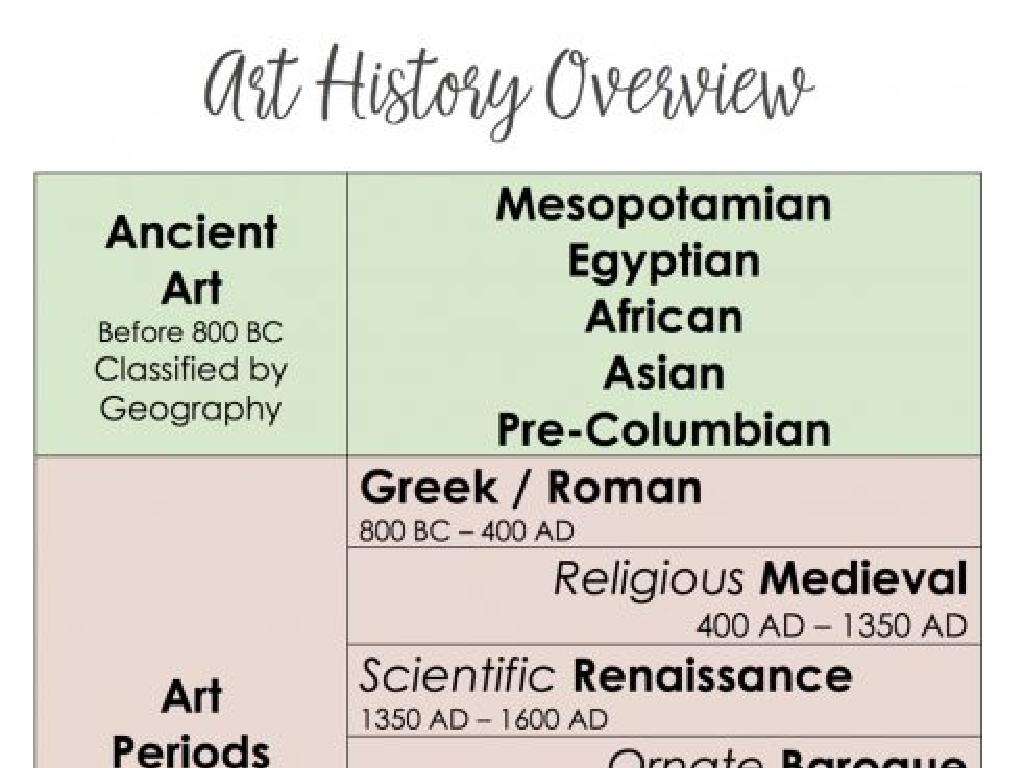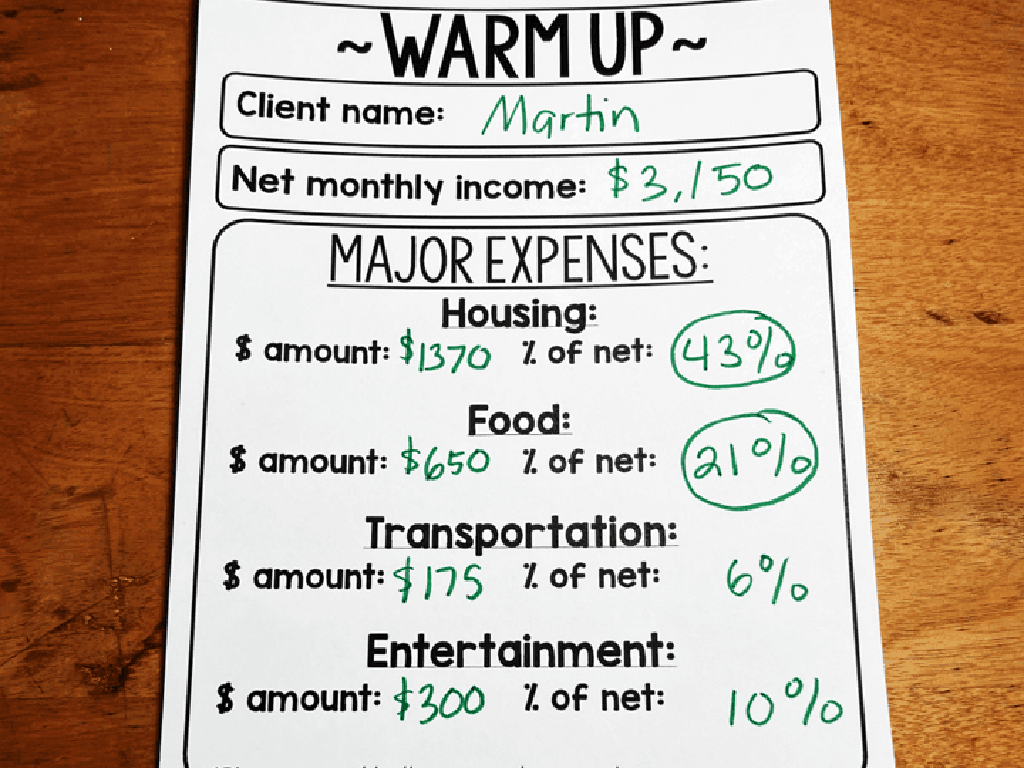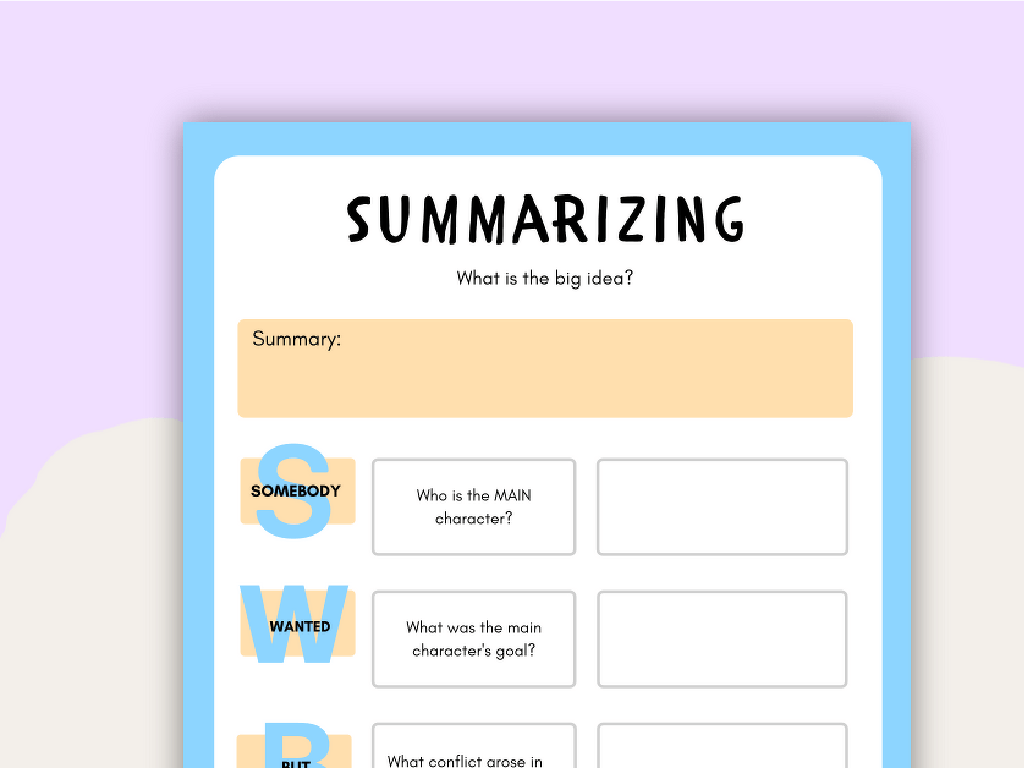Multiply Three Numbers
Subject: Math
Grade: Third grade
Topic: Two-Digit Multiplication
Please LOG IN to download the presentation. Access is available to registered users only.
View More Content
Today’s Adventure: Multiplying Three Numbers!
– Multiplication as repeated addition
– If you have 3 groups of 4 apples, that’s 3 times 4 apples.
– Multiplication in daily life
– Use it to calculate total items, like pencils in packs.
– Steps to multiply three numbers
– First multiply two numbers, then multiply the result by the third.
– Practice with examples
– Try 2 x 3 x 4 and see what you get!
|
This slide introduces third graders to the concept of multiplying three numbers, framing it as an exciting adventure. Begin by explaining multiplication as a form of repeated addition, which they are already familiar with. Emphasize the practicality of multiplication in everyday scenarios, such as figuring out the total number of items in multiple packs. Walk through the steps of multiplying two numbers and then using the product to multiply by the third number. Provide clear examples and encourage students to practice with simple numbers to build confidence. The goal is to make them comfortable with the process and understand its usefulness.
Quick Review: Multiplying Three Numbers
– Understanding two-digit multiplication
– It’s like single-digit multiplication, but with bigger numbers!
– Examples of multiplying two digits
– For instance, 23 x 15 or 42 x 36
– Let’s multiply: 12 x 3
– Step by step, we’ll do 12 x 3 as a class
– Practice makes perfect
|
This slide is a quick review of two-digit multiplication aimed at helping third graders understand the concept of multiplying larger numbers. Start by explaining that two-digit multiplication is an extension of what they already know from single-digit multiplication. Show a couple of examples on the board, such as 23 x 15 or 42 x 36, and solve them step by step. Then, as a class activity, solve 12 x 3 together, ensuring that each student follows along and understands each step. Encourage students to practice regularly as this will help solidify their understanding of the concept. The goal is for students to become comfortable with multiplying two-digit numbers by single-digit numbers.
Multiplying Three Numbers – Step by Step
– Learn to multiply three numbers
– Example: 2 x 3 x 4
– Start with 2 x 3 = 6, then multiply by 4
– Breaking down the steps
– First, multiply 2 and 3. Next, multiply the result by 4
– Practice with different numbers
– Try 5 x 3 x 2 or 4 x 2 x 6 for homework
|
This slide introduces the concept of multiplying three numbers together, which builds on the foundation of two-digit multiplication. Begin by explaining the process step by step. Use the example 2 x 3 x 4 to show students how to approach the problem by first multiplying the first two numbers, and then multiplying the result by the third number. Emphasize the importance of doing the operations in sequence and checking their work. After explaining, encourage students to practice with different sets of numbers to solidify their understanding. Provide additional examples for them to try as homework, ensuring they get ample practice with this new skill.
Let’s Practice Multiplying Three Numbers!
– Multiply 4, 5, and 2 together
– Example: 4 x 5 = 20, then 20 x 2 = 40
– Multiply 3, 6, and 1 together
– Example: 3 x 6 = 18, then 18 x 1 = 18
– Partner up for practice problems
– Work with a classmate to solve similar problems
– Share your answers with the class
|
This slide is an interactive class activity designed to reinforce the concept of multiplying three numbers. Start by demonstrating the first example on the board, showing step-by-step multiplication. Then, allow the students to try the second example with guidance. Afterward, pair the students up and provide them with a set of problems to solve together. This peer interaction will help them understand the concept better and encourage teamwork. As they work, circulate the room to offer help and check for understanding. Finally, have a few pairs share their answers and methods with the class to ensure everyone is on the same page. Possible activities for different pairs could include creating their own multiplication problems, using manipulatives to visualize the multiplication, or drawing arrays to represent the equations.
Understanding the Commutative Property
– What is Commutative Property?
– It lets us change the order of numbers we multiply.
– Helps in multiplying three numbers
– Makes multiplication easier and faster.
– Example: 5 x 3 x 2
– 5 x 3 = 15 and then 15 x 2 = 30.
– Same as 2 x 5 x 3
– Changing the order doesn’t change the answer; it’s still 30.
|
The Commutative Property of Multiplication states that changing the order of factors does not change the product. This property is fundamental in helping students understand that no matter how numbers are grouped in multiplication, the result will be the same. This simplifies the process of multiplying multiple numbers, especially when dealing with larger numbers or trying to find the easiest way to compute mentally. For example, multiplying 5 x 3 x 2 can be seen as 5 x 3 = 15, then 15 x 2 = 30. Alternatively, starting with 2 x 5 gives 10, and then multiplying by 3 also gives 30. Encourage students to practice with different numbers and to use this property to make multiplication quicker and more intuitive.
Group Activity: Multiplication Scavenger Hunt
– Find classroom objects to multiply
– Group challenge: make multiplication problems
– Use objects found to create unique problems
– Share findings with the class
– Discuss how you solved the problems with peers
– Reflect on the activity
– Think about what you learned from this game
|
This slide introduces a hands-on group activity designed to reinforce the concept of multiplying three numbers. Students will work in groups to locate objects around the classroom that can be used in multiplication problems. They will then create their own two-digit multiplication problems based on these objects. Afterward, each group will share their problems and solutions with the class, fostering a collaborative learning environment. As a teacher, prepare to facilitate the activity by ensuring there are enough objects for all groups, guiding students who may struggle with problem creation, and encouraging discussion among groups. Possible activities include multiplying the number of chairs by the number of legs, or the number of windows by the number of panes. This activity aims to make multiplication tangible and engaging.
Class Activity: Multiplication Relay Race
– Split class into relay teams
– Each team solves problems together
– Work on a multiplication problem as a team
– Pass the baton for each step
– One student solves a step, then passes to the next
– First team to finish wins!
|
This activity is designed to encourage teamwork and reinforce the concept of multiplying three numbers. Divide the class into small groups, each group representing a relay team. Provide each team with a set of multiplication problems involving three numbers. Each student in the team is responsible for one step of the multiplication process. Once they complete their step, they ‘pass the baton’ to the next team member by handing over the problem. The first team to correctly complete all their problems wins. This activity not only makes learning multiplication fun but also promotes collaboration and communication among students. Possible variations include different difficulty levels for problems or a ‘challenge round’ where teams can earn extra points.
Wrapping Up: Multiplying Three Numbers
– Key points of multiplying three numbers
– We learned to multiply step by step, starting with two numbers and then including the third.
– Significance of this multiplication skill
– Understanding this helps solve real-world problems, like buying multiple items.
– Homework: Multiplication practice
– Complete the worksheet to become a multiplication master!
|
As we conclude today’s lesson, we reflect on the process of multiplying three numbers. This skill is crucial as it lays the foundation for more advanced math concepts and everyday problem-solving, such as calculating total costs while shopping. For homework, students are provided with a worksheet that includes a variety of three-number multiplication problems to reinforce their learning. Encourage students to approach each problem methodically, ensuring they understand each step before moving on to the next. Remind them that practice is key to mastering multiplication.






